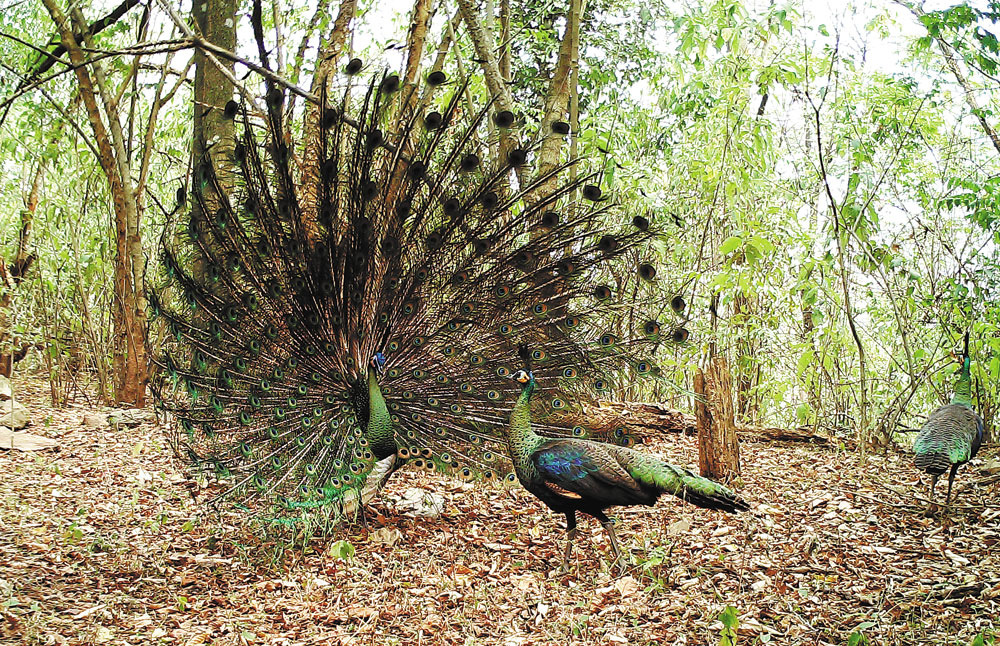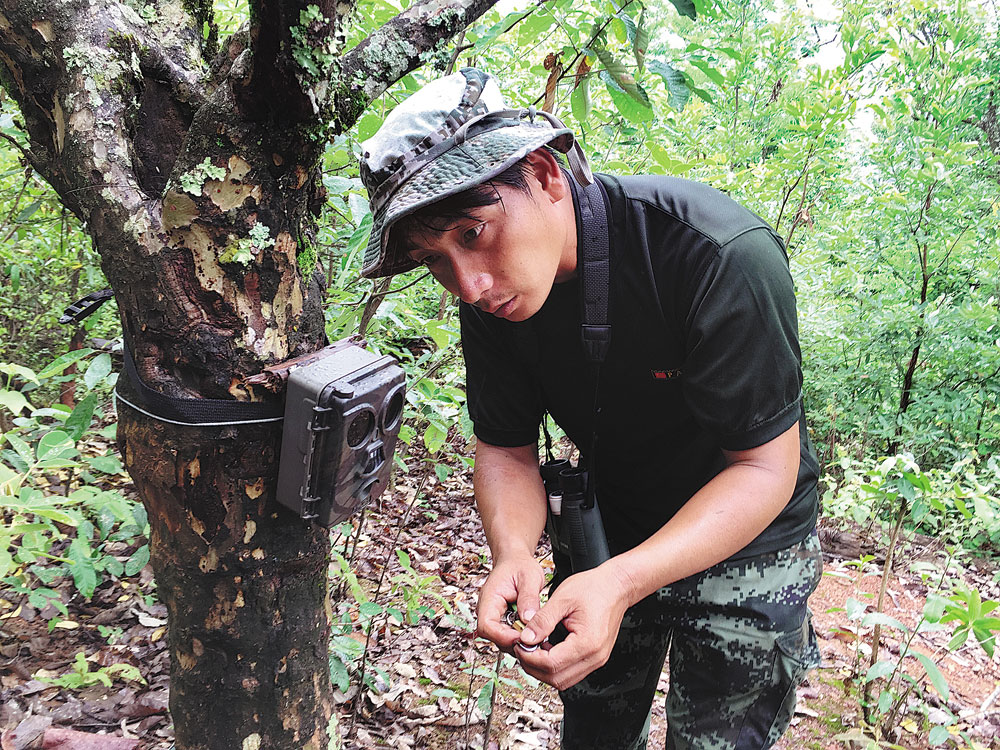
The green peafowl, China's native pheasant species, is under top-level protection as efforts are stepped up to boost numbers of the endangered birds. CHINA DAILY
Nation steps up efforts to protect green peafowl
The pheasant occupies a privileged position in China, inspiring numerous poems, paintings and songs in ancient times.
It is also believed to be linked to the mythical phoenix, which in Chinese legends was nicknamed the "king of birds".
Han Lianxian, an ornithologist at Southwest Forestry University in Kunming, Yunnan province, said: "Many Chinese people have seen pheasants. However, few have witnessed China's native pheasant species-the green peafowl, which has incredibly beautiful tail feathers and is now under top-level protection."
Blue peafowl are commonly seen in zoos and parks, Han said, adding that as China's only native pheasant, green peafowl (Pavo muticus) are bigger and have yellow checks and shiny green neck feathers.
Moreover, different from female blue peafowl, which have dark brown feathers, female green peafowl have shorter tail plumage but lustrous blue and green feathers like the males.
However, the beauty of the green peafowl has become its major threat. Males are hunted for their extravagant tail feathers. Eggs and chicks are also sought for illegal trade, and some of the birds have been poisoned by farmland pesticides.
The population of the species has declined significantly throughout East Asia since the turn of the century and it is now only reported in scattered locations in a few countries.
The green peafowl is among the most-threatened pheasants in the world. Its plight was highlighted in the International Union for Conservation of Nature's Pheasant Action Plan, where it was listed as one of the highest priorities for conservation. There are estimated to be 15,000 to 30,000 of the birds worldwide.
As the sole habitat of the green peafowl in China, the southwestern province of Yunnan has reported the species being sighted on the middle and upper reaches of the Yuanjiang River. Sightings have also been reported sporadically elsewhere in the province, such as in Puer city and several areas of Xishuangbanna Dai autonomous prefecture.
According to the Yunnan Forestry and Grassland Administration, there are 555 to 600 of the birds in the province.

The green peafowl, China's native pheasant species, is under top-level protection as efforts are stepped up to boost numbers of the endangered birds. CHINA DAILY
Impressive sight
Han, one of the country's top experts on birds, has worked in wilderness areas for decades, but has only observed a green peafowl in the wild once. Recalling this unexpected encounter, he said the beautiful bird had impressed him.
In 2002, Han was working on field research at Xiaoheishan Provincial Nature Reserve in Longling county. He had just left the reserve's forest station early in the morning and was walking along a forest path when he heard the cries of green peafowl coming from the surrounding mountains.
"Suddenly, I heard a bird's wings fluttering. Then, a large bird flew high toward the sky from a nearby cornfield. The bird saw me much sooner than I saw it. Within seconds, it had soared into the sky and disappeared into the valley," Han said.
"It was a male green peafowl, which is so quick and alert. I was stunned by its bluish-green tail feathers, which shone like jade in the sunlight. It was at that moment that you knew it was the 'king of birds'."
China is stepping up efforts to boost the endangered green peafowl population by providing the birds with a natural breeding ground in Yunnan. In recent years, local authorities, scientific institutions and public welfare organizations have strengthened efforts to revive the species.
On March 20, in the country's first public interest litigation case related to the green peafowl in Yunnan, a court ordered construction of a hydropower station to be suspended because of the damage the project would likely inflict on the birds' habitats. The ruling marked a significant step in the country's ecological conservation efforts.
The landmark decision came nearly three years after the lawsuit was filed to stop construction of the hydropower station on the Jiasa River, a stretch of the Red River in the province. The Jiasa River Hydropower Plant, which can generate 270 megawatts of electricity, cost 3.7 billion yuan ($572.7 million).
Yang Xiaojun, an ornithologist at the Kunming Institute of Zoology, a branch of the Chinese Academy of Sciences, said the conclusion that the green peafowl is likely to become extinct in China-after completion of a dam on the Jiasa River-is unwarranted and the decline of the species is due to a number of reasons.
According to surveys carried out by the institute, the species survives in 22 counties in Yunnan.
Yang said, "Agricultural expansion, habitat loss and illegal hunting have all played a part in the decline of the species. One of the main challenges facing green peafowl conservation is that more than 65 percent of the birds now live outside nature reserves."
Han said river valleys with gentle slopes, along with tropical monsoon forests, offer the birds humidity, sufficient food, water and open space, making such areas ideal habitats for the species. Recent research has also found that the birds can live in mountains where there is some open ground.

Rangers learn how to use infrared cameras to protect the green peafowl in its habitat in Xishuangbanna, Yunnan province. CHINA DAILY
Efforts intensified
In 2018, the government in Yunnan became the first provincial administration in the country to pass regulations on protecting biodiversity. As of that year, Yunnan has invested more than 11 million yuan in protecting the green peafowl, implementing monitoring systems and providing water and food sources for the birds.
From 2016 to last year, the Yunnan forestry department intensified efforts to protect the green peafowl and its habitat. It also conducted regular surveillance patrols in the birds' habitats, cracking down on illegal hunting and trade in the species.
In Xinping county-a major habitat for the species-the head of the local forestry department has led a green peafowl protection group since 2018. In the past three years, more than 6,000 leaflets and over 40,000 brochures on safeguarding the species have been distributed to residents.
In 2018, the county launched a long-term surveillance project, organizing a 25-strong patrol team. Three green peafowl observation stations have been built and 106 infrared surveillance cameras installed in the forest.
Moreover, thanks to the participation of the Society of Entrepreneurs and Ecology, an NGO promoting environmental protection in China, and the Birds Observation Association in Yuxi city, more locals have been encouraged to join efforts to protect the green peafowl.
At Yubaiding Nature Reserve in Eshan county, where the birds are frequently sighted, years of hard work by local residents have resulted in a strong affection for the species.
Shi Yongjin, a forest ranger at the reserve, said: "Public education has significantly improved people's awareness of the need to protect this endangered beautiful bird. My 1-year-old granddaughter could imitate the cry of a green peafowl before she could say 'Mama'."
As Yunnan still faces geological challenges in improving residents' lives, boosting the local economy is also important, together with the priority task of wildlife protection.
In recent years, the Society of Entrepreneurs and Ecology has promoted environmentally friendly hiking in Yuxi and invited more people to take part in work to protect the green peafowl.
Xiao Jin, program director at the society's Southwest China office, said: "We will arrange lectures about some wild species and environmental protection. Visitors will explore nature under the guidance of experts and forest rangers, obtaining a deeper understanding of how humans co-exist with nature."

Rangers learn how to use infrared cameras to protect the green peafowl in its habitat in Xishuangbanna, Yunnan province. CHINA DAILY
Breeding program
A captive-breeding program is underway-an important step to boost the green peafowl population and save the species from extinction.
In 2019, with help from the Kunming Institute of Zoology, workers started artificially breeding 21 green peafowl. By the end of that year, more than 170 eggs were produced, with 24 of them hatching successfully.
Yang said this initial success inspired researchers to carefully plan efforts to boost the green peafowl population, adding, "The success of the captive-breeding program offers new hope for the survival of one of the world's most-threatened pheasants."
However, problems have been reported with the program. Han said DNA tests showed that many newborns were not pure-bred green peafowl, but the reason for this is not yet known.
Yang Xing, head of the Birds Observation Association in Yuxi, said a yearlong survey that was started in April last year found that isolated habitats are a major crisis for the green peafowl.
"Habitats that used to be connected are now isolated by human activities, villages, roads and farmland. A lack of mating opportunities across different groups has resulted in an increasing number of newborns with physiological defects and a low hatching rate," Yang said.
Green peafowl in Jinghong, Xishuangbanna Dai autonomous prefecture, which is more than 400 kilometers from the species' major groups in Yuxi, have experienced birth defects among their young in recent years, according to the survey.
As green peafowl habitats are scattered across the province, Han and his team have been trying to link them by creating tree belts to provide a natural breeding ground for the birds.
"We got scientists and local residents involved and established 'corridors' in small areas of habitat for rare and endangered species, forming a protection net," Han said, explaining that the corridors consist of the green peafowl's favorite plants.
"This protection method is more suited to China's current land-use status and the situation in the country. Therefore, we believe this is where we should make more efforts in the future," he said.

